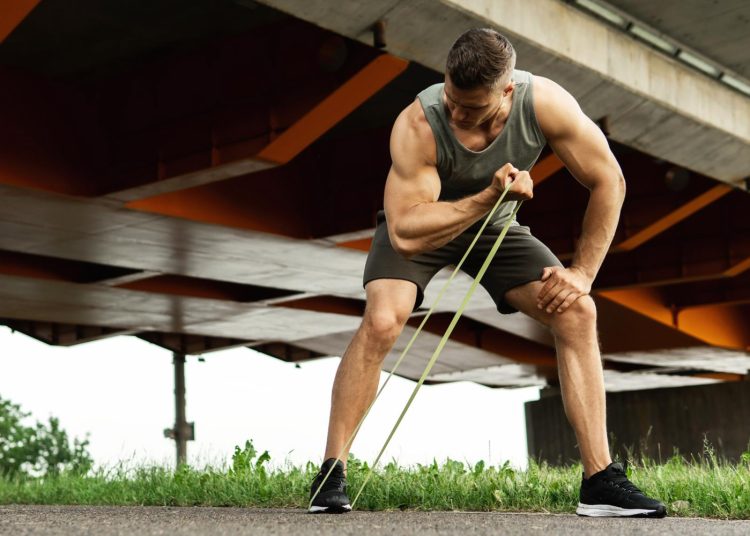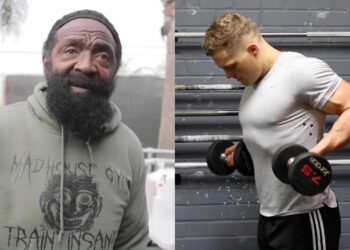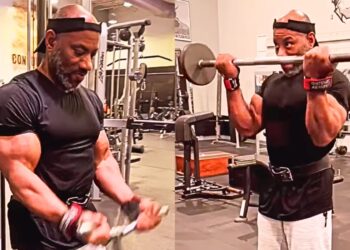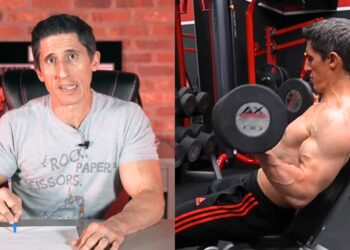If you don’t have the time or means to join a gym, using resistance bands to tone your arms can be just as effective — especially if you’re just starting out.
A systematic review and meta-analysis from 2019 found that “elastic resistance training can promote similar strength gains to conventional resistance training,” meaning you don’t have to use dumbbells, barbells, or cable machines to achieve the desired results. (1)
But what if I sweetened that deal and told you that you could build jacked arms with a 12-minute workout? Well, you could. Let me show you how.
12-Minute Resistance Band Arm Workout For Every Fitness Level
With only 12 minutes at your disposal, you must be efficient with your time and exercise choices. The following six banded exercises are guaranteed to deliver the best results in a limited time:
- Banded Bicep Curls
- Banded Tricep Pushdown
- Banded Reverse Bicep Curl
- Banded Overhead Tricep Extension
- Banded Lateral Raises
- Banded Narrow-Grip Push-Ups
Here’s how you will structure your workout depending on your fitness level:
Level Up Your Fitness: Join our 💪 strong community in Fitness Volt Newsletter. Get daily inspiration, expert-backed workouts, nutrition tips, the latest in strength sports, and the support you need to reach your goals. Subscribe for free!
Beginner-Friendly 12-Minute Banded Arm Workout
A beginner-friendly 12-minute banded arm workout will be relatively easy. You will perform each exercise for 90 seconds and immediately move on to the next exercise. The circuit should look like this:
| Banded Exercise | Duration | Resistance Level |
| Warm-Up | 3 minutes | / |
| Bicep Curls | 90 seconds | Light |
| Tricep Pushdown | 90 seconds | Light |
| Reverse Bicep Curl | 90 seconds | Light |
| Overhead Tricep Extension | 90 seconds | Light |
| Lateral Raises | 90 seconds | Light |
| Narrow-Grip Push-Ups | 90 seconds | Light |
To warm up, you’ll do bicep curls and tricep pushdowns with the same resistance band you’ll use in your working sets. Perform 8–10 reps of both exercises and then move on to active warm-ups, like arm swings or shoulder rolls, to get those joints moving.
When you start the circuit, you won’t stop until you finish the last exercise. Luckily, this circuit is only nine minutes long, excluding the warm-up. However, don’t let that fool you. Your arms will burn.
You will perform each exercise for 90 seconds, but that doesn’t mean you shouldn’t perform as many reps as you can in those 90 seconds.
Keep the reps slow and controlled. When performed with good form, each rep should take about 5 seconds. In other words, you shouldn’t be able to perform more than 20 reps within 90 seconds.
If you reach failure before the 1-minute mark, rest until the next exercise. Don’t let go of the resistance band, though. Keep the tension on your muscles in the stretched position (arms fully stretched during curls and arms bent during extensions)
Intermediate 12-Minute Banded Arm Workout
Intermediate lifters will perform a similar arm workout, but the warm-up will be outside the 12-minute circuit this time. Also, you will use a heavier resistance band, and instead of performing one set for 90 seconds, you will perform two for 60.
The circuit will go like this:
| Banded Exercise | Duration | Sets | Resistance Level |
| Bicep Curls | 60 seconds | 2 | Medium |
| Tricep Pushdown | 60 seconds | 2 | Medium |
| Reverse Bicep Curl | 60 seconds | 2 | Medium |
| Overhead Tricep Extension | 60 seconds | 2 | Medium |
| Lateral Raises | 60 seconds | 2 | Medium |
| Narrow-Grip Push-Ups | 60 seconds | 2 | Medium |
Once again, your warm-up should be a mixture of active warm-ups and exercises you will perform for 2–3 minutes — just like I explained previously.
In the circuit, you will perform each exercise for 60 seconds. Start with 60 seconds of controlled bicep curls with a medium-tension resistance band, and move on to tricep pushdowns as soon as you’re done. After you complete the push-ups, return to bicep curls and do it again.
On average, you should be able to get 10–12 reps per exercise within a 60-second window. You probably won’t reach muscular failure during the first round, but if it happens during the second, rest until the next exercise.
Advanced 12-Minute Banded Arm Workout
You must give it your all when you progress to the advanced level. You will use heavy bands and perform diamond push-ups.
Here’s what the 12-minute circuit will look like:
| Banded Exercise | Duration | Sets | Resistance Level |
| Bicep Curls | 40 seconds | 3 | Heavy |
| Tricep Pushdown | 40 seconds | 3 | Heavy |
| Reverse Bicep Curl | 40 seconds | 3 | Heavy |
| Overhead Tricep Extension | 40 seconds | 3 | Heavy |
| Lateral Raises | 40 seconds | 3 | Heavy |
| Narrow Grip Push-Ups | 40 seconds | 3 | Heavy |
Warm up the same way that I previously explained, and then start your circuit.
Just like with the intermediate circuit, you will move on from one exercise to another and restart the circle once you go through all of them. This time, we’re going for 40-second sets and doing three rounds of each exercise, totaling 12 minutes.
Instead of performing controlled reps during both the concentric and eccentric phases, you will explode during the concentric portion. In other words, I want you to pull or push as fast and as explosive as you can. The band will try to “rebound” after you pull, but don’t let it. Control the resistance during the eccentric phase for about three seconds. With this tempo, you should be able to perform 10–12 reps within 40 seconds.
How To Set Up and Perform These Banded Arm Exercises?
During my 10-year coaching career, I’ve seen numerous folks mess up when performing banded exercises because they’re deceptively simple to set up. So, here’s how to properly set up and perform these banded exercises:
Banded Bicep Curls
Bicep curls are the best bicep exercise. They perfectly target the elbow flexors (biceps brachii, brachialis, and, to some extent, brachioradialis) and even give your front delts a decent workout. To set up and perform their banded variant, do the following:
- Stand in the middle of the resistance band with your feet shoulder-width apart.
- Grab the D-handles with a supinated grip.
- Slowly curl your hands towards your shoulders, stopping at a 35–40-degree angle.
- Slowly lower your hands, controlling the weight all the way through.
Pro Tip: Keep your elbows tucked and curl straight up to maintain the line of tension directly aligned with your biceps for the best muscle engagement
Level Up Your Fitness: Join our 💪 strong community in Fitness Volt Newsletter. Get daily inspiration, expert-backed workouts, nutrition tips, the latest in strength sports, and the support you need to reach your goals. Subscribe for free!
Banded Triceps Pushdown
A tricep pushdown is another staple exercise for toning and strengthening your arms. It will effectively work all three tricep heads (long, lateral, and medial), although you will likely feel it the most in your lateral head. To set up and perform banded tricep pushdown, do this:
- Attach the band securely to a high object (preferably the stall bar rung just above your head). Loop the band around the rung and pull the band ends through the loop.
- Grab the ends of the resistance band, take a step back, and slightly lean forward. Position the elbows at your sides, creating a 30-degree angle at the elbow joint.
- Push down until your arms are fully extended, and contract your triceps at the end.
- Slowly return to the starting position, maintaining control at all times.
Pro Tip: You don’t want to attach the band too high up. Ideally, the band should pull your hands at an angle (up and forward) when you’re in the fully stretched position to keep the tension as high as possible.
Banded Reverse Bicep Curl
The reverse bicep curl is one of the best forearm exercises (it targets the brachioradialis, the meaty part of your forearm, more than the regular curl), and we don’t have any dedicated forearm-builders in the 12-minute circuit, so this is the next best thing. (2)
To perform the banded reverse bicep curl, simply reverse the grip (grab the D-handles with your palms facing down) and perform it exactly like a regular bicep curl.
Pro Tip: Don’t force your palms to stay parallel to the ground. Your hands will naturally tilt out as you curl up, so keep the angle between the palms and the floor about 30 degrees.
Banded Overhead Tricep Extension
Overhead tricep extension is arguably the best tricep exercise for targeting the long head (the meaty back portion of your arm). The long head is the biggest difference-maker when it comes to arm size, so don’t ever skip this exercise.
Here’s how to set up and execute it flawlessly:
- Attach the band securely around knee height. Loop it around the stall bar rungs.
- Grab the ends of the resistance band.
- Lean forward at around a 45-degree angle. Hold your hands above your head, with elbows bent and facing up and forward. Your hands should be behind your shoulders.
- Extend your arms until fully straight, and briefly hold at the top.
- Slowly return to the starting position, controlling the weight on your way down.
Pro Tip: If you need extra stability, you can perform this exercise while sitting down. Slide the bands underneath the bench to secure them, and pull straight up to perform the extension.
Banded Lateral Raises
While lateral raises are shoulder exercises, you can’t achieve a toned arm look without strong, well-defined side delts.
To set up and perform this exercise, do the following:
- Stand in the middle of the resistance band with your feet shoulder-width apart.
- Attach a D-handle at the end of the band, and grip the opposing handles with your palms facing down.
- Lift your arms to the side until they are at your shoulder level. Hold at the top for a brief moment.
- Slowly lower your arms and control the weight on your way down.
Pro Tip: We’re grabbing the opposing ends of the band to force additional tension and stretch at the bottom position. The band should pull your arms in front of your body, making the stretch greater and the initial pull even harder.
Banded Narrow-Grip and Diamond Push-Ups
While many consider push-ups a chest-building exercise, they are also excellent tricep exercises. The closer your hands are together, the more load will be transferred to the triceps, making this the ultimate finisher.
To perform banded push-ups (both narrow and diamond), do the following:
- Loop the band across your back and place it under your hands while in a push-up position.
- For narrow-grip push-ups, place your hands at around 70% of your shoulder width.
- For diamond push-ups, position your hands so the opposing thumbs and index fingers touch.
- Slowly lower your chest to the ground while keeping your core engaged, your back straight, and your hips tucked in.
- Explode up to the starting position.
Pro Tip: Keep your elbows tucked to engage the triceps and minimize the risk of shoulder injury.
Why Should You Train Your Arms Using Resistance Bands?
Using resistance bands instead of dumbbells offers several unique advantages, such as:
More Time Under Tension
While I certainly don’t buy into the whole “tension is king” narrative, there are benefits to keeping tension on the working muscle, which resistance bands do better than dumbells. (3)
Maintaining greater muscle tension throughout the exercise maximizes intensity compared to traditional dumbbell exercises. This results in a more effective workout and greater hypertrophy because you get closer to failure within the same number of reps.
For example, the tension at the stretched position when doing dumbbell bicep curls is basically non-existent. The same goes for overhead tricep extensions in the contracted position. Bands, on the other hand, keep your muscles actively engaged in both stretched and contracted positions, so you don’t get to rest during the movement.
Dr. Mike Israetel (Ph.D. in Sports Physiology) says that while constant time under tension is beneficial, it is not something to obsess about.
“Tension is what causes growth, not constant tension. Tension that gets you close to failure causes the most growth. If it had breaks on the way, it doesn’t matter if, towards the end of that set, many of the reps are closer to failure, whether or not you took breaks in the middle of that set or did constant tension. Either way, when you get close to failure, the growth starts being poured in. So you don’t have to do constant tension; there’s nothing magical about it.”
Safety
Resistance bands reduce the strain on your joints, tendons, and ligaments, so they’re safer to use than heavy weights, whether they’re dumbbells or barbells.
Their safety profile also makes them ideal for rehabilitation.
Portability
Bringing dumbbells with you when you’re traveling is nearly impossible — especially if you’re flying. Resistance bands, on the other hand, are super lightweight and can fit in any suitcase, allowing you to work out no matter where you are.
Cost-Effective
Resistance bands are undoubtedly the most cost-effective pieces of gym equipment ever created. A single dumbbell usually costs over $150, while a resistance band with the same tension strength costs around $20.
Wrapping Up
As you can see, even if you only have 12 minutes to spare, this simple resistance band arm workout will be more than enough to get those arms toned.
It doesn’t matter if you’re just getting started or you’re an advanced trainee. With slight adjustments to the band resistance level and your circuit, you can make the workout more or less challenging to fit your fitness level perfectly.
References:
- Lopes JSS, Machado AF, Micheletti JK, de Almeida AC, Cavina AP, Pastre CM. Effects of training with elastic resistance versus conventional resistance on muscular strength: A systematic review and meta-analysis. SAGE Open Med. 2019 Feb 19;7:2050312119831116. doi: 10.1177/2050312119831116. Erratum in: SAGE Open Med. 2020 Sep 9;8:2050312120961220. PMID: 30815258; PMCID: PMC6383082.
- Coratella G, Tornatore G, Longo S, Toninelli N, Padovan R, Esposito F, Cè E. Biceps Brachii and Brachioradialis Excitation in Biceps Curl Exercise: Different Handgrips, Different Synergy. Sports (Basel). 2023 Mar 9;11(3):64. doi: 10.3390/sports11030064. PMID: 36976950; PMCID: PMC10054060.
- Burd NA, Andrews RJ, West DW, Little JP, Cochran AJ, Hector AJ, Cashaback JG, Gibala MJ, Potvin JR, Baker SK, Phillips SM. Muscle time under tension during resistance exercise stimulates differential muscle protein sub-fractional synthetic responses in men. J Physiol. 2012 Jan 15;590(2):351-62. doi: 10.1113/jphysiol.2011.221200. Epub 2011 Nov 21. PMID: 22106173; PMCID: PMC3285070.










